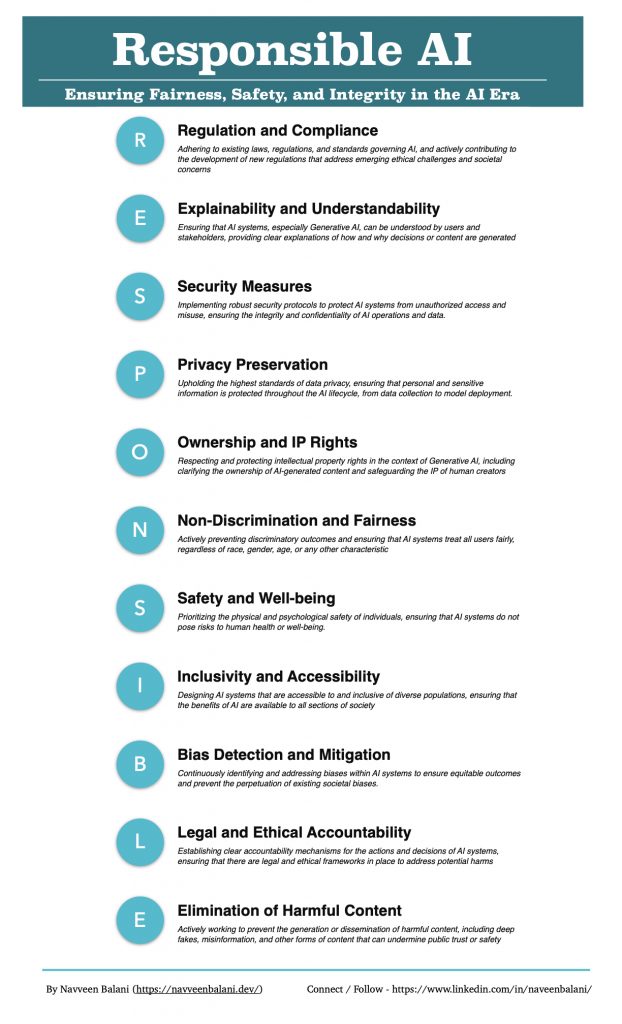Navigating the realms of Artificial Intelligence (AI) and Generative AI, the imperative for robust ethical and responsible practices has never been more pronounced. This reality underscored the need for a guiding principle that transcends mere compliance to embed responsibility at the heart of technological advancement. That’s why I crafted the “RESPONSIBLE” framework, reflecting my view on the necessity of a comprehensive strategy. This isn’t merely a set of guidelines but a foundational approach to ensure AI’s growth is ethical, upholds societal values, and champions human rights. My framework aims to serve as a compass, guiding AI development towards responsible innovation and societal betterment, emphasizing that as AI technologies evolve, they do so with an unwavering commitment to the principles of responsibility.
The “RESPONSIBLE” Framework Explained
Let’s dive into the main parts of this framework, with each principle acting as a key support for maintaining AI’s integrity and responsible growth
R – Regulation and Compliance
Adhering to existing laws, regulations, and standards governing AI, and actively contributing to the development of new regulations that address emerging ethical challenges and societal concerns.
E – Explainability and Understandability
Ensure that AI systems, especially Generative AI, can be understood by users and stakeholders by providing clear explanations of how and why decisions or content are generated.
S – Security Measures
Implementing robust security protocols to protect AI systems from unauthorized access and misuse, ensuring the integrity and confidentiality of AI operations and data.
P – Privacy Preservation
Upholding the highest standards of data privacy, ensuring that personal and sensitive information is protected throughout the AI lifecycle, from data collection to model deployment.
O – Ownership and IP Rights
Respecting and protecting intellectual property rights in the context of Generative AI, including clarifying the ownership of AI-generated content and safeguarding the IP of human creators.
N – Non-Discrimination and Fairness
Actively preventing discriminatory outcomes and ensuring that AI systems treat all users fairly, regardless of race, gender, age, or any other characteristic.
S – Safety and Well-being
Prioritizing the physical and psychological safety of individuals, ensuring that AI systems do not pose risks to human health or well-being.
I – Inclusivity and Accessibility
Designing AI systems that are accessible to and inclusive of diverse populations ensures that the benefits of AI are available to all sections of society.
B – Bias Detection and Mitigation
Continuously identifying and addressing biases within AI systems to ensure equitable outcomes and prevent the perpetuation of existing societal biases.
L – Legal and Ethical Accountability
Establish clear accountability mechanisms for AI systems’ actions and decisions, ensuring that legal and ethical frameworks are in place to address potential harms.
E – Elimination of Harmful Content
Actively working to prevent the generation or dissemination of harmful content, including deep fakes, misinformation, and other forms of content that can undermine public trust or safety.
Here is a one-page view of Responsible AI

Forward Together with Ethical AI
The “RESPONSIBLE” framework can serve as a guiding light in our shared journey towards ensuring the ethical development and deployment of AI, including Generative AI. It extends an invitation to the AI community to join in a commitment to responsible innovation, laying the groundwork for a future where AI technologies are developed and utilized with the highest ethical standards, integrity, and respect for human dignity. Together, we can ensure that AI serves as a force for positive societal transformation, guided by principles that prioritize the welfare and advancement of society as a whole.



